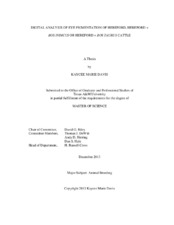| dc.contributor.advisor | Riley, David G. | |
| dc.creator | Davis, Kaycee Marie | |
| dc.date.accessioned | 2014-05-13T17:30:36Z | |
| dc.date.available | 2015-12-01T06:31:15Z | |
| dc.date.created | 2013-12 | |
| dc.date.issued | 2013-12-02 | |
| dc.date.submitted | December 2013 | |
| dc.identifier.uri | https://hdl.handle.net/1969.1/151943 | |
| dc.description.abstract | Ocular neoplasia in cattle with white faces contributes to large production losses. It occurs less frequently in cattle with pigmented eyelids. Corneoscleral pigmentation (irregular extension of color from the iris into the sclera) is related to eyelid pigmentation and possibly ocular neoplasia. The objectives of this study were to evaluate eyelid and corneoscleral pigmentation using digital images and objective quantification of pixel intensities (the color of eyelid and corneoscleral regions within the image) to obtain a proportion of eyelid and corneoscleral pigment. Hereford, Hereford × Bos indicus and Hereford × Bos taurus animals were included in the study (n = 1083). Upper and lower eyelid pigment proportions and corneoscleral pigment proportions were determined independently. Fixed effects included breed type, age categories and sex of the animal. Lesion presence (1) or absence (0) was obtained by visual appraisal and was assumed binomially distributed. Left eyelid pigmentation proportions (averaged for upper and lower eyelids) for Hereford (0.67 ± 0.021) were significantly lower than Bos indicus (0.94 ± 0.011) or Bos taurus (0.92 ± 0.011) crosses. Right eyelid pigmentation proportions (averaged for upper and lower eyelids) differed (P < 0.05) for Hereford (0.68 ± 0.022), Bos indicus (0.94 ± 0.011) and Bos taurus (0.90 ± 0.011). Corneoscleral pigmentation proportions (averaged for left and right eyes) differed for each of the three breed types, Hereford (0.05 ± 0.034), Bos indicus (0.32 ± 0.018) and Bos taurus (0.40 ± 0.016). Mature animals (0.34 ± 0.017) had a significantly greater proportion of corneoscleral pigment than did the calves and yearlings (0.17 ± 0.018). Proportion of lesion presence for Hereford (0.07 ± 0.022) was significantly more than Bos indicus (0.01 ± 0.005) or Bos taurus (0.01 ± 0.003). By age category, mature animals (0.06 ± 0.011) had significantly greater presence of lesions than did the calves and yearlings (0.01 ± 0.002). There were strong positive correlations for upper and lower eyelid, between left and right eyelids and between eyelid and corneoscleral pigmentation. Crossbreeding with Bos taurus or Bos indicus animals increase pigmentation and possibly inhibit incidence of ocular neoplasia. | en |
| dc.format.mimetype | application/pdf | |
| dc.language.iso | en | |
| dc.subject | Hereford | en |
| dc.subject | cancer eye | en |
| dc.subject | eyelid pigmentation | en |
| dc.title | Digital Analysis of Eye Pigmentation of Hereford, Hereford x Bos indicus or Hereford x Bos taurus Cattle | en |
| dc.type | Thesis | en |
| thesis.degree.department | Animal Science | en |
| thesis.degree.discipline | Animal Breeding | en |
| thesis.degree.grantor | Texas A & M University | en |
| thesis.degree.name | Master of Science | en |
| thesis.degree.level | Masters | en |
| dc.contributor.committeeMember | DeWitt, Thomas J. | |
| dc.contributor.committeeMember | Herring, Andy D. | |
| dc.contributor.committeeMember | Hale, Dan S. | |
| dc.type.material | text | en |
| dc.date.updated | 2014-05-13T17:30:36Z | |
| local.embargo.terms | 2015-12-01 | |


